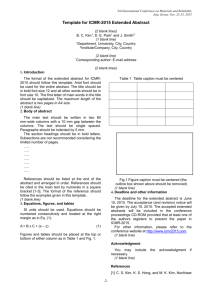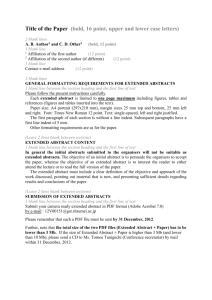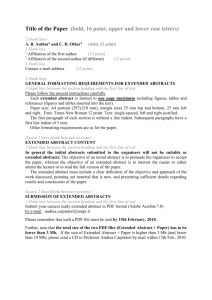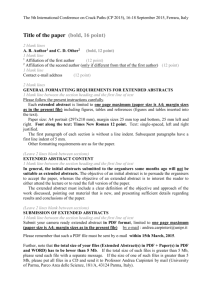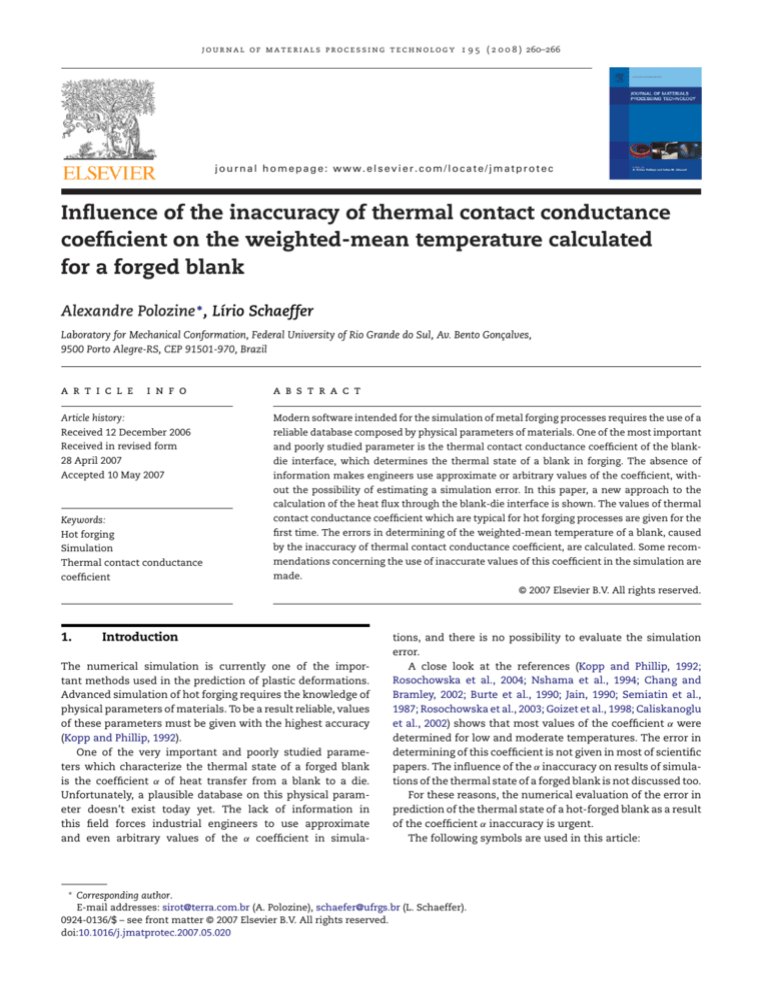
j o u r n a l o f m a t e r i a l s p r o c e s s i n g t e c h n o l o g y 1 9 5 ( 2 0 0 8 ) 260–266
journal homepage: www.elsevier.com/locate/jmatprotec
Influence of the inaccuracy of thermal contact conductance
coefficient on the weighted-mean temperature calculated
for a forged blank
Alexandre Polozine ∗ , Lı́rio Schaeffer
Laboratory for Mechanical Conformation, Federal University of Rio Grande do Sul, Av. Bento Gonçalves,
9500 Porto Alegre-RS, CEP 91501-970, Brazil
a r t i c l e
i n f o
a b s t r a c t
Article history:
Modern software intended for the simulation of metal forging processes requires the use of a
Received 12 December 2006
reliable database composed by physical parameters of materials. One of the most important
Received in revised form
and poorly studied parameter is the thermal contact conductance coefficient of the blank-
28 April 2007
die interface, which determines the thermal state of a blank in forging. The absence of
Accepted 10 May 2007
information makes engineers use approximate or arbitrary values of the coefficient, without the possibility of estimating a simulation error. In this paper, a new approach to the
calculation of the heat flux through the blank-die interface is shown. The values of thermal
Keywords:
contact conductance coefficient which are typical for hot forging processes are given for the
Hot forging
first time. The errors in determining of the weighted-mean temperature of a blank, caused
Simulation
by the inaccuracy of thermal contact conductance coefficient, are calculated. Some recom-
Thermal contact conductance
mendations concerning the use of inaccurate values of this coefficient in the simulation are
coefficient
made.
© 2007 Elsevier B.V. All rights reserved.
1.
Introduction
The numerical simulation is currently one of the important methods used in the prediction of plastic deformations.
Advanced simulation of hot forging requires the knowledge of
physical parameters of materials. To be a result reliable, values
of these parameters must be given with the highest accuracy
(Kopp and Phillip, 1992).
One of the very important and poorly studied parameters which characterize the thermal state of a forged blank
is the coefficient ˛ of heat transfer from a blank to a die.
Unfortunately, a plausible database on this physical parameter doesn’t exist today yet. The lack of information in
this field forces industrial engineers to use approximate
and even arbitrary values of the ˛ coefficient in simula-
∗
tions, and there is no possibility to evaluate the simulation
error.
A close look at the references (Kopp and Phillip, 1992;
Rosochowska et al., 2004; Nshama et al., 1994; Chang and
Bramley, 2002; Burte et al., 1990; Jain, 1990; Semiatin et al.,
1987; Rosochowska et al., 2003; Goizet et al., 1998; Caliskanoglu
et al., 2002) shows that most values of the coefficient ˛ were
determined for low and moderate temperatures. The error in
determining of this coefficient is not given in most of scientific
papers. The influence of the ˛ inaccuracy on results of simulations of the thermal state of a forged blank is not discussed too.
For these reasons, the numerical evaluation of the error in
prediction of the thermal state of a hot-forged blank as a result
of the coefficient ˛ inaccuracy is urgent.
The following symbols are used in this article:
Corresponding author.
E-mail addresses: sirot@terra.com.br (A. Polozine), schaefer@ufrgs.br (L. Schaeffer).
0924-0136/$ – see front matter © 2007 Elsevier B.V. All rights reserved.
doi:10.1016/j.jmatprotec.2007.05.020
j o u r n a l o f m a t e r i a l s p r o c e s s i n g t e c h n o l o g y 1 9 5 ( 2 0 0 8 ) 260–266
261
Nomenclature
area of convection heat exchange (m2 )
blank-die interface (m2 )
area of radiation heat exchange (m2 )
height of the blank (m)
heat capacity of the blank material at constant
pressure (J/kg K)
d
diameter of the blank (m)
E
error in calculation of the weighted-mean temperature of the blank, caused by the inaccuracy
of the coefficient ˛ (◦ C)
hT
convection heat exchange coefficient (W/m2 K)
m
blank mass (kg)
P
ratio between the arbitrary and correct values
of the thermal contact conductance coefficient
at the blank-die interface
t
cooling time of the blank (s)
T
temperature of the free surface of the blank (K)
Tdie
work surface temperature of the die (K)
Tinitial
weighted-mean temperature of the blank at the
initial moment of its forging (K)
Tblank
temperature of the blank surface in contact
with the die (K)
Tt(incorrect) weighted-mean temperature of the blank,
calculated on the base of the arbitrary coefficient ˛1 (K)
weighted-mean temperature of the blank, calTt(real)
culated on the base of a correct value of the ˛
(K)
T∞
temperature of the environment (air) (K)
qinterface heat flux density from the blank to the die
(W/m2 )
Qconv
convective heat flux from the free surface of the
blank (W)
Qinterface heat flux from the blank to the die (W)
Qrad
radiant heat flux from the free surface of the
blank (W)
Qtotal
total heat flux from the blank (W)
Aconv
Ainterface
Arad
b
Cp
Greek symbols
˛
coefficient of thermal contact conductance for
the blank-die interface (W/m2 K)
˛1
arbitrary value of thermal contact conductance
coefficient for the blank-die interface (W/m2 K)
Stefan–Boltzman constant (W/m2 K4 )
total emissivity of the blank free surface at the
εT
temperature T
Fig. 1 – Macroscopic model of the blank-die contact zone
proposed by Li and Sellars (Li and Sellars, 1996).
layers of the blank and die, as well as on the oxide films, air
bubbles, etc.
Detailed analysis of the contact zone identifies a large number of factors that affect the process of heat transfer through
this zone. The factors are as follows:
-
The nature of heat transfer through a contact zone is more
complicated (Kreith and Bohnt, 2003) than the heat transfer in
a homogeneous medium. Therefore, the Law of Fourier which
describes the quantity of thermal energy transferred by conduction through a homogeneous medium cannot be applied
in this case.
Listed factors cause great difficulties in experimental studies of thermal contact conductance of the blank-die interface.
Boutonnet (Boutonnet, 1998) cites the simplified (empirical) formula that may be used in calculations of heat transfer
through the blank-die interface:
Qinterface = ˛ · Ainterface · (Tblank − Tdie ).
3.
2.
Nature of the thermal contact
conductance
The heat transfer from a forged blank to a die occurs by conduction, convection and radiation (Kreith and Bohnt, 2003).
The model of the blank-die contact zone is shown in Fig. 1.
Fig. 1 shows that the heat flux, which goes through the contact zone, depends on thermophysical properties of surface
Chemical composition of the oxide films in the contact zone.
Thickness of oxide films in the contact zone.
Thickness of lubricant layer between the blank and the die.
Quantity of air in the contact zone.
Microgeometry of the blank and die surfaces (roughness).
Blank and die temperatures.
Pressure in the contact zone.
Thermophysical properties of the blank and die materials.
Thermophysical properties of the lubricant.
Thermophysical properties of the oxide films.
(1)
Methods of determining the coefficient ˛
According to the formula (1), in order to determine the coefficient ˛, it is necessary to know the heat flux Qinterface from
the blank to the die, the heat transfer area (Ainterface ) and the
surface temperatures (Tblank, Tdie ) in the contact zone.
Measuring the heat transfer area is not any problem. The
main problem is determining the surface temperatures in the
contact zone and calculating the heat flux through the blankdie interface.
262
j o u r n a l o f m a t e r i a l s p r o c e s s i n g t e c h n o l o g y 1 9 5 ( 2 0 0 8 ) 260–266
Boutonnet (Boutonnet, 1998) cites three main methods to
determine the coefficient˛. These methods are as follows:
• Experimental method of direct measurement of surface
temperatures in the contact zone.
• Experimental method of indirect determining of surface
temperatures in the contact zone.
• Mixed method based on processing experimental data by
means of software used for the simulation of the temperature distribution in the blank-die system.
The inaccuracy of the ˛ coefficient obtained by experimental methods (Rosochowska et al., 2004; Nshama et al.,
1994) is approximately (5–5.5) % for the small values and about
(23.5–33) % for the large values.
The determination of the ˛ coefficient by mixed methods (Kopp and Phillip, 1992; Chang and Bramley, 2002;
Caliskanoglu et al., 2002) introduces the inaccuracy in the simulation program output. The error of the simulation cannot
be evaluated in this case, as available simulation programs
require the input of many other parameters whose accurate
values are also unknown.
4.
Method to evaluate the influence of the ˛
inaccuracy on predicting the real thermal state
of the blank
To estimate the numerical error in predicting the thermal state
of the hot-forged blank, caused by the ˛ inaccuracy, the following method was used:
• Determining the range of typical (averaged) values of the ˛
coefficient on the base of the formula (1) and statistical data
(Kopp and Phillip, 1992) about the heat flux density from the
blank to the die, which were obtained for hot forging.
• Determining variations in the weighted-mean temperature
of the blank, considering these variations as a function of
the extreme values (maximum and minimum) of the ˛ coefficient from the typical ones for hot forging. (Calculation of
the weighted-mean temperature is performed on the base
of the Law of Energy Conservation.)
5.
Theoretical assumptions
The following assumptions are made to study the influence
of the ˛ inaccuracy on predicting the real thermal state of the
blank in hot forging:
• Instead of unknown or inaccurate values of thermal contact
conductance coefficient ˛ are considered its averaged values
which can be calculated on the base of typical heat fluxes
from the blank to the die (Kopp and Phillip, 1992).
• The minimum value of the ˛ coefficient from the typical
ones for hot forging characterizes materials with a thick
oxide layer (carbon steels).
• The maximum value of the ˛ coefficient from the typical
ones for hot forging is peculiar to materials with a thin oxide
layer (aluminium alloys).
Table 1 – Extreme values of the heat flux density
according to Kopp and Phillip
Unit
Heat flux density
Minimum value
W/m2
155 × 104
Maximum value
1000 × 104
• Materials with intermediate thickness of an oxide layer have
values of the ˛ being between the mentioned extreme values of this coefficient.
• Calculated weighted-mean temperature of the blank at
moment t of forging, obtained on the base of a correct value
of the ˛ coefficient, is equal to the real weighted-mean temperature Tt(real) of the blank at the same moment.
6.
Determining the range of ˛ averaged
values which are typical for hot forging
The range of ˛ averaged values which are typical for hot forging
may be calculated by using heat flux densities. The mathematical relation between the heat flux density qinterface and
the heat flux Qinterface is given by equation:
Qinterface = qinterface · Ainterface .
(2)
By combining Eq. (2) and formula (1), the Eq. (3) has been
obtained. Eq. (3) expresses the ˛ in terms of the heat flux
density:
qinterface = ˛ · (Tblank − Tdie ).
(3)
The density of heat flux qinterface from a blank to a die was
determined for hot forging by Kopp and Phillip (Kopp and
Phillip, 1992). The extreme values of qinterface are shown in
Table 1.
The blank materials chosen for calculations were AISI 1045
carbon steel and AA 6061 aluminium alloy. The initial temperatures for these materials were as follows: 1473 K for steel;
773 K for aluminium alloy. The initial temperature of the die
is assumed to be 465 K.
By substituting, in the Eq. (3), the values of qinterface from
the Table 1 and initial temperatures of the blank-die interface,
the Eqs. (4) and (5) for calculating the extreme averaged values
of the ˛ have been obtained:
155 × 104 = ˛minimum × (1473 − 475);
(4)
1000 × 104 = ˛maximum × (773 − 475).
(5)
The minimum value of ˛ for steels is shown in Table 2. The
maximum value of ˛ for aluminium alloys is shown in Table 3.
Thus, as it is possible to see from the Tables 2 and 3, a
range of the ˛ coefficient typical values for hot forging is
(1550–33560) W/m2 ·K.
The same method was used for the calculation of the ˛
for a titanium alloy. In this case, the blank temperature was
900 ◦ C and the weighted-mean temperature of the die was
550 ◦ C. The following averaged values of ˛ have been obtained
j o u r n a l o f m a t e r i a l s p r o c e s s i n g t e c h n o l o g y 1 9 5 ( 2 0 0 8 ) 260–266
263
Table 2 – The minimum value of the ˛ coefficient for a steel blank in hot forging
Unit
Minimum value from the typical ones
b
c
1800b (Burte et al., 1990)
2700c (Rosochowska et al., 2004)
1550a
W/m2 K
a
Minimum value according to literature
The value was calculated for AISI 1045 steel.
The value was determined for “H13–H13” steel interface.
The value was determined for “Ma8–H13” steel interface.
Table 3 – The maximum value of the ˛ coefficient for an aluminium blank in hot forging
Unit
Maximum value from the typical ones
W/m2 K
a
b
c
Maximum value according to literature
30000b (Jain, 1990)
50000c (Nshama et al., 1994)
33560a
The value was calculated for AA6061aluminium alloy.
The value was determined for “Al6061-O”–“H12 steel” interface.
The value was determined for “Al6061-O”–“4140 steel” interface.
(4400–28500) W/m2 ·K. These results are within a range of the
˛ values which are typical for hot forging on the whole. Thus,
a range of the ˛ averaged values, which was determined for
carbon steels and aluminium alloys, is useful also for materials with intermediate physical properties such as titanium
alloys.
7.
Balance of thermal energy in hot forging
process
Qtotal = m · Cp ·
dTt(real)
dt
= ˛ · Ainterface · (Tblank − Tdie )
4
+ · Arad · εT · (T 4 − T∞
) + hT · Aconv · (T − T∞ ).
(9)
Taking into consideration that the blank cooling velocity
dTt /dt is approximately equal to
In order to obtain the equation that expresses the dependence
between the temperature of the forged blank and the ˛, the
blank cooling process (Fig. 2) is examined.
The mathematical model of forged blank cooling is based
on the Law of the Energy Conservation (6), on the formula (1)
of heat transfer through the contact zone, shown above, on
the Stefan–Boltzmann Eq. (7) and the Law of Newton (8):
Qtotal = Qinterface + Qrad + Qconv ,
The resulting equation is:
(6)
Tinitial − Tt(real)
t
,
the Eq. (9) of the energy balance can be rewritten as follows:
m · Cp ·
Tinitial − Tt(real)
t
4
)
≈ ˛ · Ainterface · (Tblank − Tdie ) + · Arad · εT · (T 4 − T∞
+ hT · Aconv · (T − T∞ ).
(10)
where:
4
Qrad = · Arad · εT · (T 4 − T∞
),
(7)
Qconv = hT · Aconv · (T − T∞ ).
(8)
8.
Error E of the blank weighted-mean
temperature
In order to calculate the error E of the temperature Tt(incorrect),
the following steps are performed:
(a) the Eq. (10) is re-written by substituting a correct value of
the ˛ for an arbitrary value of the ˛1 and by substituting
the temperature Tt for the temperature Tt(incorrect) which
corresponds to the ˛1 , i.e.:
m · Cp ·
Tinitial − Tt(incorrect)
t
4
)
≈ ˛1 · Ainterface · (Tblank − Tdie ) + · Arad · εT · (T 4 − T∞
+ hT · Aconv · (T − T∞ );
Fig. 2 – Scheme of the blank cooling process.
(11)
264
j o u r n a l o f m a t e r i a l s p r o c e s s i n g t e c h n o l o g y 1 9 5 ( 2 0 0 8 ) 260–266
Table 4 – Initial conditions of blank hot forging and blank thermophysical parameters
Blank material
Tinitial
Tblank
Tdie
T
T∞
˛
AA 6061
AISI 1045
773
1473
773
1473
475
475
773
1473
298
298
33560a
1550b
a
b
εT
hT
0.27 (Polozine, 2004)
0.83 (Polozine, 2004)
10 (Schaeffer, 1999)
10 (Schaeffer, 1999)
The maximum value of the ˛ coefficient from the typical ones.
The minimum value of the ˛ coefficient from the typical ones.
Table 5 – Varying parameters of hot forging used in the calculation of the E
b/d
P = (␣1 /␣)
2
a
b
1.5
1
0.5
2.0 ÷ 0.5
Tt(real)
[773–573]a , [1473–1173]b
For the blank of aluminium alloy.
For the blank of steel.
(b) the Eq. (10) is divided into the Eq. (11). The resulting expression for closed die forging (εT = 0; hT = 0) is as follows:
Tinitial − Tt(incorrect)
Tinitial − Tt(real)
≈
˛1
= P,
˛
(12)
where:
E = Tt(real) − Tt(incorrect) .
Thus, to calculate a value of the E, it is necessary to give the
Tinitial, Tt(real) and P.
The resulting expression for the calculation of the E in the
case of open dies (εT > 0; hT > 0) is derived similarly. Deriving
this expression, it is necessary to give the geometry of a blank
as the ratio b/d, where b is a height of a blank and d is its
diameter. Calculations for this case are not shown in the given
paper.
9.
Parameters used to calculate the error E
of the blank weighted-mean temperature
Initial conditions of blank forging conditions and blank thermophysical parameters that have been used in the calculation
of the E are shown in Table 4.
Varying parameters that were used in the calculation of the
E are shown in Table 5.
10.
Fig. 3 – Error E of the weighted-mean temperature of a
blank, caused by the ˛ inaccuracy. Closed die forging,
[900–1200] ◦ C range.
determine the simulation error E. These conditions are as follows:
(a) Hot forging method (open or closed dies):
• For the range of low temperatures, the error E of the temperature Tt(real) of a blank forged in open dies is almost
the same as in the case of closed dies i.e:
Eopen die = 0.93Eclosed die ;
Results
The results of the E calculation show the influence of the ˛
inaccuracy on prediction of the thermal state of a hot-forged
blank. The calculation of the E value was performed for the
following cases:
• Closed die forging.
• Open die forging (for b/d = 2).
• P = 2; 1.5; 1.25; 0.75; 0.5; 0.25 (arbitrary values).
Expected error E calculated on the base of arbitrary value of
the ratio P is shown in Figs. 3–6. The analysis of Figs. 3–6 permits to draw the conclusions about some conditions which
Fig. 4 – Error E of the weighted-mean temperature of a
blank, caused by the ˛ inaccuracy. Closed die forging,
[300–500] ◦ C range.
j o u r n a l o f m a t e r i a l s p r o c e s s i n g t e c h n o l o g y 1 9 5 ( 2 0 0 8 ) 260–266
265
E = ±16.5 ◦ C, (˛1 /˛ = ±1.055, steel forging for closed dies, cooling interval 300 ◦ C).
E = ±10.3 ◦ C, (˛1 /˛ = ±1.055, steel forging for open dies, cooling
interval 300 ◦ C).
E = ±66 ◦ C, (˛1 /˛ = ±1.33, aluminium forging for closed dies,
cooling interval 200 ◦ C).
E = ±61.4 ◦ C, (˛1 /˛ = ±1.33, aluminium forging for open dies,
cooling interval 200 ◦ C).
Some conclusion may be also deduced by analyses of the
expressions of the shape (11) derived for the cases of closed
and open dies. These conclusions are the following:
Fig. 5 – Error E of the weighted-mean temperature of a
blank, caused by the ˛ inaccuracy. Open die forging,
[900–1200] ◦ C range, b/d = 2.
• For the range of high temperatures, the error E of
the temperature Tt(real) of a blank forged in open dies
is significantly greater than in the case of closed
dies, i.e.
Eopen die = 0.62Eclosed die .
(b) Range of cooling temperatures of a forged blank:
• The module of the error E of the temperature Tt(real) is
directly proportional to the width of the range of blank
cooling temperatures in forging process.
(c) Ratio P:
• If P > 1, the error E of the temperature Tt(real) is directly
proportional to P;
• If P < 1, the module of the error E of temperature Tt(real)
is inversely proportional to P.
The case, in which the ˛1 variate within the limits of experimental error in determining the ˛ (Rosochowska et al., 2004;
Nshama et al., 1994), represents an especial interest. The ratio
P for this case is as follows:
P = 1.055 for a steel forging;
P = 1.33 for a aluminium forging.
Expected error E calculated for the coefficient ˛ obtained by
experimental way is as follows:
• For closed dies, the error E of the temperature Tt(real) of a
blank does not depend on the blank macrogeometry;
• For open dies, the error E of the temperature Tt(real) of a blank
increases in proportion to the ratio between a diameter and
height of a blank (ratio b/d).
11.
Conclusion
The analysis of results shows that, in general case, if the ˛
coefficient is given incorrectly, this may cause the error of a
few tens or even hundreds of degrees Celsius when simulating the thermal state of a blank. Therefore, the ˛ coefficient
determined for one blank-die interface should not be used for
any other blank-die interface.
The only exception may be made for forging at high temperatures in open dies. In this case, the similarity between the
blank-die system with the known coefficient ˛ and the blankdie system under examination must be very high. Besides this,
the blank material in the system under examination must
have a high emissivity and the interface of this system must
have a low value of the coefficient ˛. Under these conditions,
the error E obtained in simulation by using the incorrect ˛ may
be acceptable. It should be noted that the simulation error
E ≤ 30.7 ◦ C for aluminium alloy blanks and E ≤ 3.4 ◦ C for carbon steel blanks, calculated for each 100 ◦ C of the forged blank
cooling, is the best result for today. Hence, such error may be
considered as acceptable for hot forging.
Acknowledgement
This research was carried out with financial support of the
CNPq of Brazil.
references
Fig. 6 – Error E of the weighted-mean temperature of a
blank, caused by the ˛ inaccuracy. Open die forging,
[300–500] ◦ C range, b/d = 2.
Boutonnet, A.-S., 1998. Etude de resistance thermique decontact
a l’interface de solides de deformables en frottement:
application aux procedes de forgeage. L’institut National des
Sciencec Applliquees de Lyon, Lyon (in French,
http://csidoc.insa-lyon.fr/these/1998/marchand/titre.pdf).
Burte, P.R., Yong-Taek, I.M., Altan, T., et al., 1990. Measurement
and Analysis of heat transfer and friction during hot forging.
ASME J. Eng. Ind. 112, 332–339.
266
j o u r n a l o f m a t e r i a l s p r o c e s s i n g t e c h n o l o g y 1 9 5 ( 2 0 0 8 ) 260–266
Caliskanoglu, D., Baouni, M.Al., Volles, R., Leisten, B., Leitner, H.,
Ebner, R., Kopp, R., 2002. Influence of heat-transfer-coefficient
on the temperature stress of hot forming steels. In:
Proceedings of Euromech435, Valenciens, pp. 201–208.
Chang, C.C., Bramley, A.N., 2002. Determination of heat transfer
coefficient at the work piece-interface for the forging process.
J. Eng. Manufacture 216 (8), 1183–1184.
Goizet, V., Bourouga, B., Bardon, J.P., 1998. Experimental study of
the thermal boundary conditions at the workpiece–die
interface during hot forging. In: Proceedings of 11th IHTC, vol.
5, South Korea, pp. 15–20.
Jain, V.K., 1990. Determination of heat transfer coefficient for
forging applications. J. Mater. Shaping Technol. 8, 193–202.
Kopp, R., Phillip, F.-D., 1992. Physical parameters and boundary
conditions for the numerical simulation of hot forming
processes. Steel Res. 63 (9), 394.
Kreith, F., Bohnt, M.S., 2003. Princı́pios de transferência de calor.
Pioneira Thomson Learning, São Paulo, p. 9 (in Portuguese).
Li, Y.H., Sellars, C.M., 1996. Evaluation of interfacial heat
transfer and friction conditions and their effects on hot
forming process. In: 37◦ MWSP Conf. Proc., ISS, l33, pp.
385–393.
Nshama, W., Jeswiet, J., Oasthuizen, P.H., 1994. Evaluation of
temperature and heat transfer conditions at the
metal-forming interface. J. Mater. Process. Technol. 45,
637–642.
Polozine, A., 2004. Desenvolvimento da Técnica para
Determinação dos Parâmetros Térmicos de Contorno,
aplicados ao Projeto de Peças Forjadas, Dissertação (Mestrado
em Engenharia), Escola de Engenharia, Programa de
Pós-Graduação em Engenharia de Minas, Metalúrgica e de
Materiais-PPGEM, Porto Alegre-RS, pp. 72, 80, 85, 86 (in
Portuguese).
Rosochowska, M., Balendra, R., Chodnikiewicz, K., 2003.
Measurements of thermal contact conductance. J. Mater.
Process. Technol. 135, 207.
Rosochowska, M., Chodnikiewicz, K., Balendra, R., 2004. A new
method of measuring thermal contact conductance. J. Mater.
Process. Technol. 145, 212–213.
Schaeffer, L., 1999. Conformação Mecânica. Imprensa Livre, Porto
Alegre, p. 47 (in Portuguese).
Semiatin, S.L., Collings, E.W., Wood, V.E., et al., 1987.
Determination of the interface heat transfer coefficient for
non-isotermal bulk-forming processes. J. Eng. Ind. 109, 49–57.






